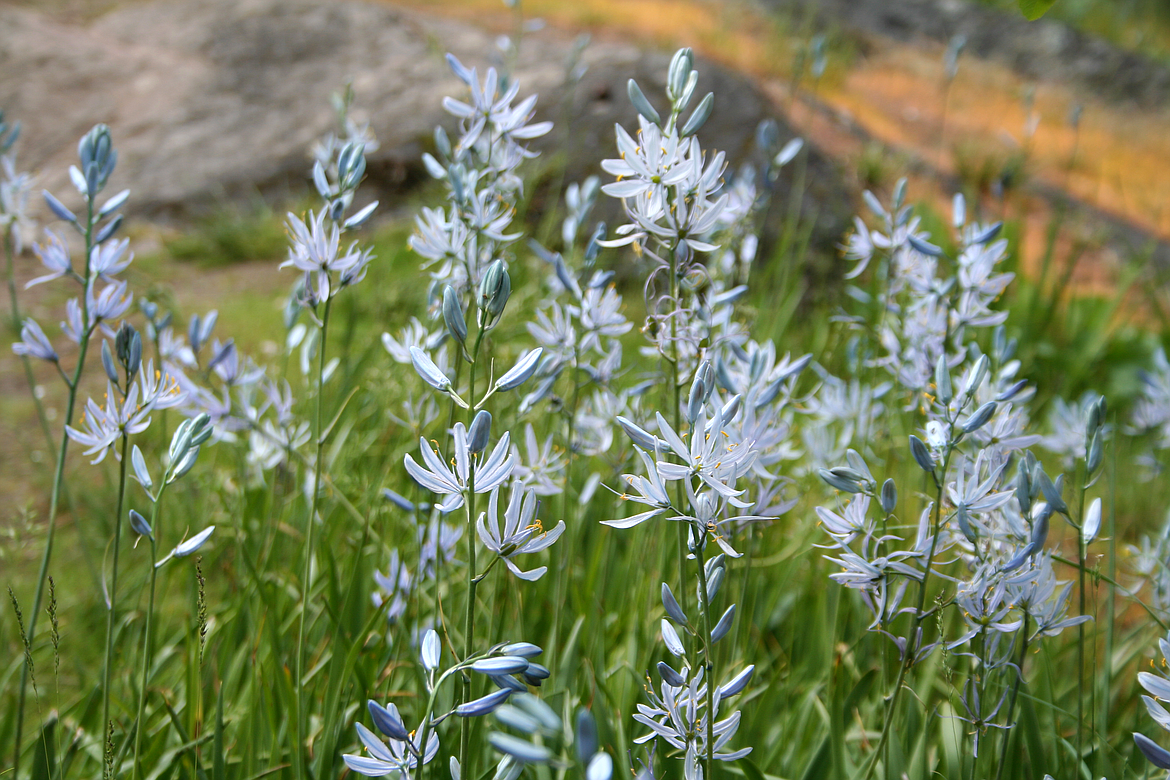Camas' uses, history honored at arboretum
Throughout human history people have fought and died over natural resources. In the mid-nineteenth century, Camas (Camassia quamash) was just such a resource. This perennial native in the Lily family grew abundantly in moist meadows and grasslands from southern British Columbia to northern California on both sides of the Cascade Crest and into Montana, Wyoming, Nevada and Utah.
Camas was a food staple for many of the native American tribes inhabiting these areas. It was gathered annually and even cultivated by some tribes. Camas was much more than an important food, it was celebrated and the annual harvest brought communities together. One Nez Perce origin story depicts Camas as a gift of the Gods, left behind by coyote to make the people glad.
As whites moved west they trampled traditional Camas prairies. Those who settled plowed the land and let cattle and pigs roam, eating plants, digging up the bulbs and destroying the habitat. Along with anger at the US government over broken treaties, this threat to native peoples' cultural and physical existence was a driving factor in the 1863 Nez Perce reservation break-out and the Bannock Wars of 1877.
Camas was unknown to science until it was collected by Meriwether Lewis. In 1805, members of the Lewis and Clark party, near starvation, were befriended by the Nez Perce who provided them with Camas bulbs on Quawmash Flats (Weippe Prairie, in present-day Clearwater County, Idaho). Lewis later noted that blooming meadows of Camas “resemble lakes of fine clear water.”
The scientific name for Camas is a bit redundant. The genus name Camassia is derived from the Nez Perce Indian word “camas” or “quamash” (which is its species name) meaning sweet. It has many common names including small camas, blue camas, prairie camas, and wild hyacinth.
Camas flowers are light blue-lavender to rich purple-blue appearing in late spring to early summer. They are arranged in loose racemes on stalks reaching from eight inches to two feet. The star-shaped flowers are symmetrical, with six narrow, inch-long tepals (three petals and three sepals that are indistinguishable from each other). In the center of the flower is a three-part stigma (a female part of the flower) surrounded by six stamens (a male part of the flower) on slender stems topped by pollen-bearing anthers. A Camas bed makes an impressive display of spring color both in the wild and in the garden.
Flowers, when fertilized, produce a three-part capsule with five or more hard, black seeds inside. The capsule splits open releasing the seeds when they are ripe. Leaves emerging in early spring are grass-like with long, thin basal blades which often die back after flowering.
Characteristic of lilies, Camas plants grow from fleshy bulbs with fibrous roots, important to Native tribal cultures as a food source. Most commonly Camas bulbs, ranging in size from a dime to a quarter, were dug using an elk horn tool in early summer after lower flowers wilted. Harvesting Camas while flowers are still evident makes it unlikely to accidentally confuse it with Death Camas, a similar looking bulb which can be fatal, but with white flowers.
Camas bulbs were cooked in every imaginable way, but the favored technique was roasting in earth ovens, pits dug in the ground and lined with rocks. After heating the rocks with a fire in the pit, moist vegetation was used to line the pit and the bulbs were placed inside. They were then covered with bark and soil and another fire was constructed on top. Bulbs were left to slowly roast for up to two days.
This long, slow cooking time is important to turn inulin (a starch difficult for humans to digest) into easily digested fructose, giving Camas a sweet taste not unlike that of sweet potatoes. Camas is highly nutritious with a protein content higher than salmon, another northwest food staple.
Camas harvesting and roasting was a time of celebration, and people living away from Camas fields traveled great distances to participate. What wasn't consumed at the party was dried for later use or used to barter. Today, some northwest tribes are reviving Camas cultivation and its traditional uses.
Camas prefers rich soil that is moist in the spring but dries through the summer. It is sun loving, but will tolerate partial shade. In the garden it makes an attractive addition to moist garden beds, water features and open meadows. It can be propagated by seed or by bulblets, which grow several seasons before blooming. Once established Camas beds will create a blanket of spring color for many years.
Camas grows in the riparian habitat of the North Idaho Native Plant Arboretum, 611 S. Ella Ave., in Sandpoint. Pictures and a description are found in “Landscaping with Native Plants in the Idaho Panhandle,” a KNPS publication available at local bookstores and the Bonner County History Museum.
Native Plant Notes are created by the Kinnikinnick Native Plant Society. To learn more about KNPS and the North Idaho Native Plant Arboretum, visit nativeplantsociety.org.

